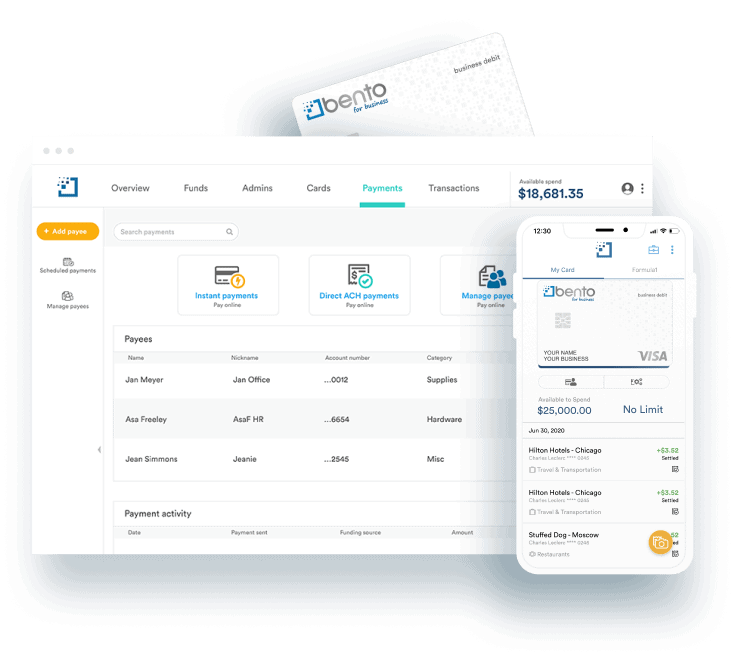
Spend Management Strategies You Need To Implement
- Why You Need a Spend Strategy
- Spend Management Vs Budgeting
- The Benefits of Having a Spend Management Game Plan
- What To Use To Develop a Spend Strategy
Business spending is always a serious decision. You must choose wisely what you’ll buy, how much to spend, where to buy it, where the money comes from, and how much profit it will bring back to your business. Now, you may want to keep your costs as low as possible, compensate your team, and maximize profits, but this is easier said than done. You need a good spend management strategy to help you plan your finances and accelerate your business growth.
So, what is a spend management strategy, and how do you create one for your company? Read on to find out.









Spend Management Strategy Defined
A spend management strategy is a financial tool for assessing your business spending. It helps you to achieve the following key goals:
- Lower your expenses
- Improve productivity
- Streamline your workflows
- Stay compliant with accounting regulations
Use a spend management strategy for transparency into your company transactions, from small expenses like office supplies to major costs like a company merger and acquisition. Spend management strategies also break down the complex nature of business finances, and keep track of income that flows in and out of your company.
In addition, spend management strategies:
- Contribute to your company policies regarding procurement, data handling, payroll, supply chain management, outsourcing, and more.
- Reduce the risk you face in the marketplace.
- Give you the best possible value for your money.
Spend Management Versus Budgeting
The critical difference between spend management and budgeting is that spend management is more about the specific procurement process. A spend management strategy focuses on keeping procurement costs down. It uses AI-driven software to automate processes such as sourcing, negotiating contracts, pre-approval, tracking supplies, and record-keeping, among others.
Budgeting, however, is a company-wide financial management tool that works within a set amount of capital. A spend management strategy must fall within the company budget, which has its limits and controls. Spend management strategies help identify and limit discrepancies between the company budget and expenses.
Spend Management Versus Expense Management
Spend management considers every type of expenditure in a business, from utilities to inventory and purchases. Anything that a business procures falls under spend management. But expense management is more about company policies around spending. This includes tracking company credit and debit cards, handling low-cost purchases, managing reimbursements, and overseeing approval processes for each type of expense.
What Are the Benefits of a Spend Management Strategy?
1. Better Cash Flow
One of the most immediate benefits of spend management strategies is cost savings. Businesses can unearth thousands of dollars every month that they otherwise lost in unnecessary or untraceable employee and supply chain expenses.
This additional cash can be redirected back into the business to fuel marketing, recruitment, R&D, or other crucial business tasks.
2. Reduced Debt
Since your spend management strategy uncovers plenty of internally generated money, it ultimately reduces your need to take loans to finance your business. In fact, a healthy cash flow means you can negotiate for better interest rates or clear your debt quicker.
3. Locked Pricing Options
Use a spend management strategy to determine the ideal prices for your company’s supplies and materials. This way, you can negotiate supply chain contracts that lock costs that would otherwise increase because of inflation.
4. Better Transparency
A spend management software is the best way to gather accurate expense data for your business. Use the spending insights to spot bottlenecks, cut down on overheads, and scale up your business.
5. Tax Compliance
Poor business spending often leads to penalties when tax season comes around. You can have successful audits, avoid fines, and get better tax breaks when you meet compliance requirements with good spend management strategies.
6. Streamlined Business Functions
A spend management strategy continuously keeps your workflows organized. Instead of letting your expenses get out of hand, it’s much easier to invest in spend management software. It monitors all company bank cards and payment records and keeps clean, accurate financial business data.
7. Improved Supply Chain Management
Payment delays are the leading cause of damaged supply chain relationships. To prevent this, use your spend management strategy to keep track of your payments to all your suppliers. This leads to much better products and customer satisfaction as your business grows.
8. Eliminate Duplicate Payments
Cash leaks often come from duplicate entries in company invoices. When you conduct a financial audit, you may discover that one invoice appears more than once in the accounting ledger, or there is a double entry for one type of purchase because of poor expense tracking.
These duplication errors throw your books right out of balance. A spend management strategy ensures that your expense records from all sources are updated to make accounting easier.
How to Develop A Spend Management Strategy

Here are the key steps to take when you develop a spend management strategy for your company, no matter the industry or size of your business.
1. Outline Your Expense Sources
The main expenses in a business include:
- Rent
- Utilities
- Raw materials
- Salaries
- Marketing
- Recruitment
- Training
- Insurance
- Maintenance
Of course, each company has a different source of expenses, but the most important thing is understanding exactly where your money is going. Once you have a comprehensive spend infrastructure, you identify cash leaks and opportunities for savings.
2. Centralize Your Expense Data
It’s easier to manage your spend data when it’s housed in one central repository like spend management software. You can automate the data entry from spreadsheets or other sources into your spend management software. Run the software to spot duplicates, clean up your data, and automatically update your accounting solutions.
As a precaution, set up the correct permissions to access your spend management software. Link your business debit cards to smart apps for your team, then assign an accountant or CFO to maintain data security.
3. Verify Your Expense Records
There are two main steps in spend data verification: matching and wiping. Matching simply means verifying that the data captured in your spend management software matches your transaction documentation like receipts, invoices, vouchers, or inventory.
Wiping means eliminating duplicates, typing, or grammar mistakes in your captured expense data. There are clear challenges at this step of developing a spend management strategy, but here are their solutions:
- Human error during data entry: Use uniform templates to gather spend data from each department in your business.
- Poor work culture: Instead of multiple people in charge of enterprise spending, or worse, individual employees spending company funds as they please, choose a reliable team leader to improve your financial outcomes.
- Slow spend management software integration: Use an AI-driven spend management solution that works seamlessly with your essential business tools like accounting software, email client, CRM, and quotation systems.
4. Create Spending Categories
Business expenditures come in numerous types, from procuring office supplies to paying for lunch with a client. Every expense must contribute to the overall vision of your business. Otherwise, it’s unnecessary spending.
There are two broad categories of business expenses that build the foundation of your spend management strategy:
- Deductible expenses:
Utilities, rent, advertising, transport, office supplies, insurance, training, charity contributions, maintenance, and repairs.
- Non-deductible expenses:
Government fines, federal income, estate taxes, political contributions, renovations to the long-term property, or other costs that are not common in your profession.
Get into as much detail as possible for each type of spend data to give you an accurate view of your expenses.
5. Study Your Expense Data
Now that you have all your expense data in one software, dive in to discover insights into your business spending. Run your spend management software reports to generate user-friendly information about your expenses.
Identify which costs are recurring and which are one-time purchases or even unauthorized payments that must be accounted for. With this data, you can estimate how much your business should reasonably spend to maintain profitable operations. The more aware you become of your spending trends, the better you can anticipate and prepare for different business needs.
Best Practices for Your Spend Management Strategy
Once you follow the above steps to create your spend management strategy, there are fundamental guidelines to keep in mind going forward. The best practices below can streamline your business spending and save precious cash:
- Requisition
The first step in any business spending is formally requesting an item or service for your company. Automate your requisition process to ensure that only the right team members use the proper credit or debit cards for the correct expenses.
- Quotation approval
Eliminate bottlenecks in authorizations through your spend management solution. When approvals flow automatically to your finance team, you can make plenty of cost savings simply from the improved efficiency.
- Quality control
Ensure that every procured item meets your standards upon delivery. Establish the right processes for returning faulty or substandard items to meet delivery timelines.
- Invoicing
Automate your invoicing process to allow only quality approved items for your business. You can trigger scheduled payments to reach your vendors in time and build a better supply chain system.
How to Automate Your Spend Management Strategy
Your spend management strategy helps you track transactions and automatically prevent unauthorized spending in your company. Finance teams have difficulty cutting checks to reimburse employees for company spending, especially if the expenses didn’t go through any formal procurement process.
Instead of facing these significant losses that only show up during audits, use a spend management solution like Bento. This unique solution can save thousands of dollars in your everyday business expenses. Bento functions just like a debit card rather than a credit card.
With a secure Bento debit card, you can:
- Set daily spending limits for specific expense categories, including international transactions
- Eliminate tedious approval processes
- Track expenses in real-time instead of poring through monthly credit card statements
- Customize card usage for each type of employee
- Easily match expenses with AI-powered receipt capture
- Export spending data to your accounting software
Bento Versus Business Credit Cards
For many businesses, it’s only natural to choose a credit card for spend management strategies—we’re already familiar with credit cards for our finances.
Unfortunately, that’s precisely why credit cards aren’t cut out for business. A Bento Visa debit card comes with lots of additional business-specific features to save you over 15% on your company expenses.
These include:
- Bento corporate debit cards:
- No credit ratings
- No delayed reimbursements for business travel and entertainment
- Online real-time tracking through the MyBento app
- Unauthorized transactions instantly declined and reported
- Funds insured by The Bancorp Bank, N.A.
- Bento virtual debit cards:
- No physical plastic card, just a virtual card number linked to your account
- Higher online fraud protection
- No need to write checks
- Limited to online or phone transactions
- No need to withdraw cash to reload the card
- Option to have a one-time virtual card with an expiry date
- Leftover funds credited back to the originating account
As you can see, Bento is a great tool for your spend management strategy. It frees you from the limitations of a traditional bank account while retaining the functions of any insured Visa debit card. The extra features integrate easily with any business, so you can create customized spending profiles for each Bento card user in each company department.
If you want to save thousands of dollars for your business in your spend management strategy, get in touch with Bento today. Signing up is easy: no credit checks, no personal guarantees, and all you need is the Bento app on your smartphone to manage your team’s spending on the go.
Other Helpful Articles

Let Bento Help Your Manage Business Spending
Learning how to manage your business spending before and not after the fact is what Bento is all about. Bento is an intuitive spend management

How Virtual Cards Can Change the Spending Management for Teachers & Educational Organizations
Overview How Virtual Cards are Helping Teachers and Educators Do Virtual Cards Benefit Non-Profit Organizations? The Bento Spend Management Platform Offers Endless Controls for Virtual





